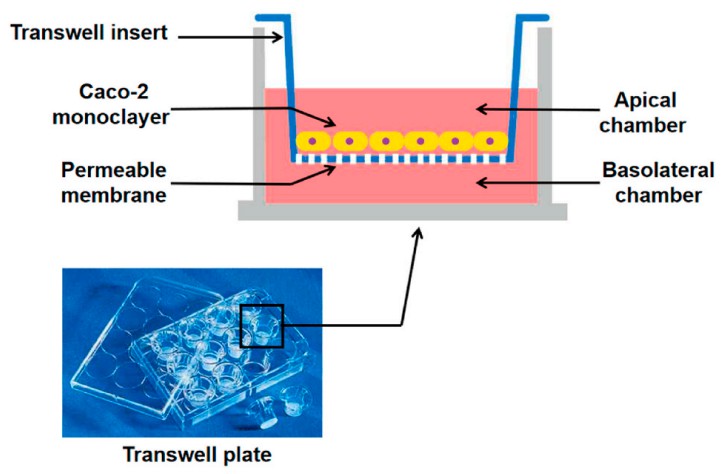Caco-2 cells, a human colon epithelial carcinoma cell line, express transporter proteins, efflux proteins, and phase II conjugation enzymes to mimic various transcellular pathways as well as metabolic transformation of test substances. The major functional difference between Caco-2 cells and normal intestinal cells is the lack of expression of cytochrome P450 isozymes, especially CYP3A4, in Caco-2 cells. When cultured as a monolayer, Caco-2 cells differentiate to form tight junctions between cells, which can serve as a model of passive diffusion of compounds across the monolayer.
Under specific culture conditions, Caco-2 cells become differentiated and polarized, with intercellular tight junctions, a well-differentiated brush border, and typical small intestinal nutrient transporters, very similar to enterocytes lining the small intestine, so they are considered an ideal model for intestinal absorption simulations. The Caco-2 permeability screen is considered to be more representative of human absorption in mimicking processes such as transcellular transport, paracellular transport, and some aspects of efflux and active transport. Due to the advantages of this method, the Caco-2 permeability has become the gold standard method for evaluating the passive and active transport and absorption of orally administered drugs.
 Figure 1. Conventional transwell plate and schematic diagram of Caco-2 cell model (Ding, X.M.; et al. 2020)
Figure 1. Conventional transwell plate and schematic diagram of Caco-2 cell model (Ding, X.M.; et al. 2020)
As an experienced service provider in molecular discovery and research, Profacgen offers high-quality Caco-2 permeability assay to predict human intestinal permeability and to investigate drug efflux. Our Caco-2 cell monolayer permeability assay is easy to perform and requires only a small quantity of compounds for the entire experiment. During the experiment, the solution of the test compound is placed on either the apical or basolateral side of the monolayer, and after a certain period (e.g., 2 hours) of incubation, the concentration of the compound and its transport rate are measured by LC-MS or LC-MS-MS, assesses the permeability of a compound on the apical side (apical to basolateral (AP-BL)) and basolateral side (basolateral to apical (BL-AP)), and identifies whether a compound undergoing active transport/efflux. Use buffers that do not contain HEPES to minimize the inhibition effect of uptake transporters. In addition, our platform also meets the needs of customers for high-throughput experiments, and provides 24-well or 96-well cell culture plates for Caco-2 parallel culture and testing of cell monolayers.
*The transport rate of a particular concentration of a test compound is usually expressed as the apparent permeability coefficient (Papp).
Profacgen has accumulated lots of experience in PROATCs. Our professional technical team can provide customers with high-quality Caco-2 permeability assay and many related featured services. Our competitive prices and extensive expertise have earned us the trust of our collaborators. Contact us to find out how Profacgen could be of assistance.
References
Fill out this form and one of our experts will respond to you within one business day.